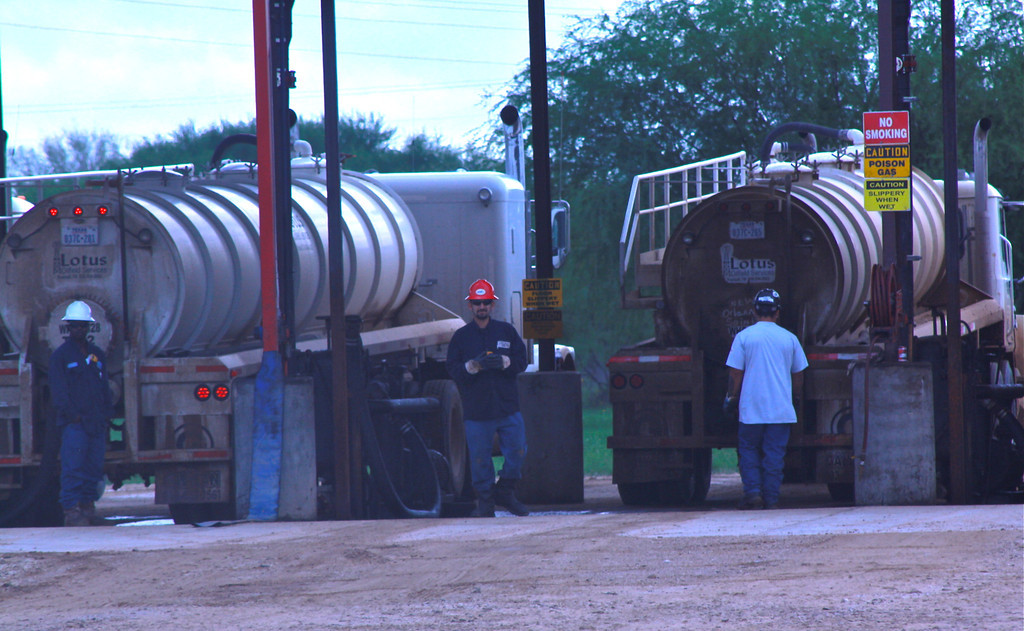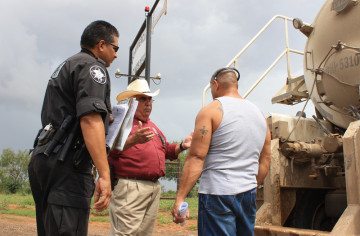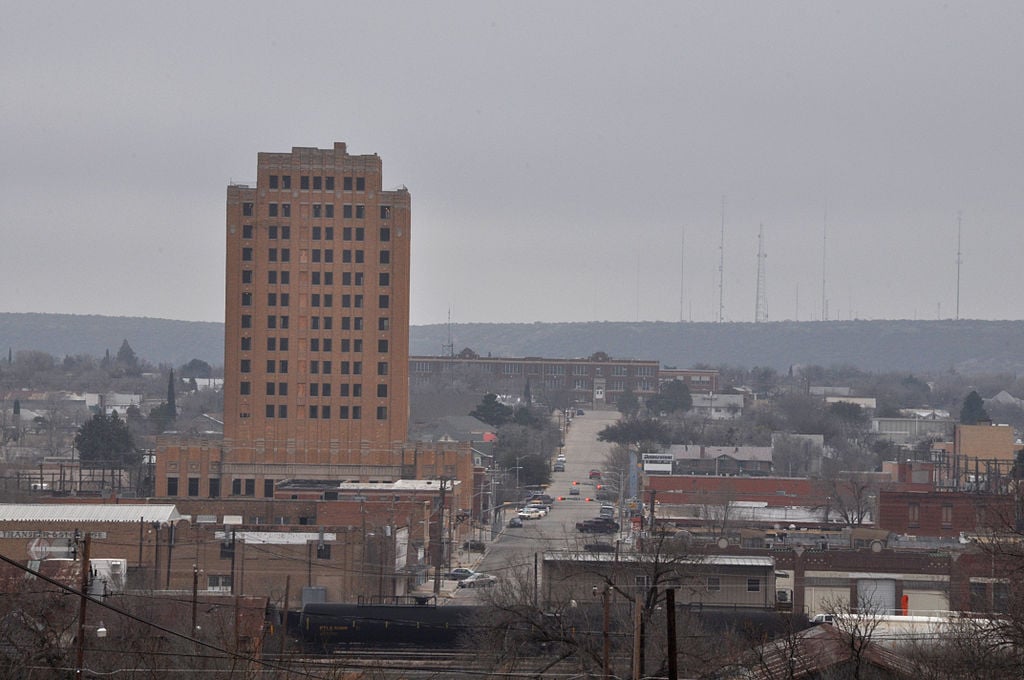
Waste Land: Frio County Struggles with Fracking’s Leftovers
Above: Frio County disposal well has trucks lined up and the smell of hydrogen sulfide heavy over the highway.
On a gravel road in rural Frio County, sheriff’s deputies are doing something they never thought they would—enforcing state environmental laws in the oil patch.
The truck drivers they were ticketing were certainly surprised.
“No, I don’t understand,” a muscular truck driver with “In God I Trust” tattooed across his chest insists from behind his recently-emptied trailer. “I don’t understand why some deputy is pulling me over. You’re not TxDOT.”
“Let me tell you again,” says Hector Zertuche, a Jim Wells County environmental crimes officer, before ticking off the applicable points of the state water code one more time.

Fifty yards away, another trucker is waving his arms as a Frio County deputy inspects his paperwork at the entrance of the Catarina Saltwater Disposal site, one of 20 saltwater disposal wells now operating in what may be the waste epicenter of the 30-county Eagle Ford Shale play. The other counties of the Eagle Ford Shale pull out the oil and gas; Frio County pumps the wastewater from fracking back down.
On this September day, Zertuche is leading a day-long training of Frio County officers to spot violations of environmental laws. The exercise is part of a local effort to bring some order to an explosion of oilfield disposal wells and trucks hauling wastewater to these otherwise quiet and largely agricultural communities.
Worried about roadway spills, well fires and explosions, wrecked roads and even injection-aggravated earthquakes associated with the wastewater disposal business, Frio County residents have been scrambling to slow an ever-growing waste stream from fracking by all possible means. There have been public hearings, meetings with state regulators, a county-level resolution opposing new disposal permits and unsuccessful efforts to get state laws changed to require all flowback water from to be cleaned and recycled.
There are only a handful of wells producing oil and gas from the deep rock formation in Frio County. But the tiny towns of Pearsall and Dilley and the web of county roads stitching them together are prowled day and night by a seemingly endless number of trucks hauling wastewater from surrounding counties.
Though careful not to come out sounding as if they’re NIMBYs, dozens of local residents turned out at a July public meeting in Dilley to complain about their burgeoning status as the region’s dumping ground. “Not all people practice the same rules,” Frio County Judge Carlos Garcia said at the time. “We’ve had spills here and there from the disposal trucks and most of the time we don’t know what chemicals are in the spills.”
After each hydraulic fracturing of a well, a process that can take several million gallons of water to splinter the compressed shale rock, a portion of that water returns to the surface as “flowback” water. Along with the water come traces of fracking chemicals, hydrocarbons, minerals and metals, and radioactive elements that had previously been entombed in the rock. In Texas, most of this wastewater is disposed by shooting it deep underground.
In addition to 10 disposal wells used solely for the benefit of the energy companies that own them, Frio County has another ten commercial wells open to make a profit that are enjoying something of a bonanza of late. Each well accepts between 10,000 to 25,000 barrels of waste every day. All told, the Texas Railroad Commission permits the operators of the commercial and private injection wells here to daily inject as much as as 124,000 barrels of waste, or 5.2 million gallons. Seven more disposal wells have been approved by the commission but aren’t yet operational, and still more permit applications are pending.
County officials estimate there’s been a 756 percent increase in the amount of fracking waste brought to Frio County since 2010 and that this year alone will see an estimated 351,720 truck trips because of it.
By way of comparison, nearby Atascosa County has only 10 disposal wells compared to Frio’s 20. Wilson County a mere five.
“In a perfect world, you wouldn’t need a disposal well at all,” said state Rep. Tracy King, D-Batesville, who carried several reform efforts in the last legislative session. House Bill 2992, for instance, would have prohibited flowback water from being shot down disposal wells as waste unless it was determined the water could not be recycled for reuse by the oil companies, reclaimed by local or state drinking-water systems, or diverted to some other “beneficial use.”
“Basically, most of the water would have had to be recycled,” King said. “It was a pretty aggressive piece of legislation.” Too aggressive for the Texas Railroad Commission, which argued it would have required an additional $1.4 million dollars annually, including the hiring of 21 full-time employees. The bill died in committee.
The sheer amount of truck traffic is another obvious concern here. County and farm-to-market roads are being torn up, said Sally Velasquez, a consultant working for Frio County, and so far only one disposal company has agreed to county requests to donate funds to help maintain the roads they’re using.
Back at the Catarina disposal well, neither of the drivers stopped by Zertuche and the Frio County deputies—their second and third stops of the day—had the proper permits to dispose at the well. “I’d heard for a long time that some companies were taking waste here they weren’t supposed to,” one deputy said. “But I always assumed that [regulating] it was a state thing.”
Beyond accidents and illegal dumping, events that have historically followed all oilfield activity, there is the daunting issue of earthquakes. A paper published this summer in Science found that larger injection wells have the capacity to weaken existing geologic faults and trigger earthquakes. “Long-term and high-volume injection in deep wells clearly carries some risk,” writes William Ellsworth, of the U.S. Geological Survey’s Earthquake Science Center, “even though most wells are apparently aseismic.” The sites that present the greatest risk, perhaps unsurprisingly, are those that inject the most waste at the greatest pressures, he found.
Garcia and others point to Shelby County in East Texas, site of numerous earthquakes over the last couple of years, including one this year that led to property damages. While the specific cause of those quakes is contested, at least one University of Texas seismologist sees a possible disposal link. The area of historically low seismic activity now boasts 21 disposal wells, according to Railroad Commission data, and has seen a boom in natural-gas production in recent years.
Last week, a planned Railroad Commission hearing over a proposed two-well, 50,000 barrels-per-day disposal site in Frio County was struck from the agenda at the last minute. A small group of Frio County residents and elected leaders had planned on attending to protest licensing what, if approved, would be the largest disposal well in the county.
Freshwater is generally drawn from less than 2,000 feet in Frio County and the disposal wells target areas deeper than 4,000 feet, below confining clay and rock strata. But a July town hall meeting in Dilley Louisiana-based environmental chemist Wilma Subra raised concerns about possible future contamination. Subra told the group that such disposal wells should have cement casing set throughout all the potential potable water zones, or as deep as 3,000 feet. “As of 2010, none—zero—of the wells had surface casing set through the complete layer of usable groundwater,” she said. “Some of them had surface casing as shallow as 700 feet.”
Frio County commissioners want to be authorized to charge disposal companies 1.5 cents per barrel of injected waste to build up an emergency fund “in case of a catastrophe, a spill, an explosion,” Garcia said. “We’re not going to have the resources to respond to something like that.”
With little oilfield production, Frio County simply isn’t seeing its resource base increase in a way that keeps pace with the risks, he said.
And it’s not just environmental risks.
“You have more burglaries. You have more drugs. You have more car accidents,” said Frio County Sheriff’s deputy Alfredo Arocha. “With this kind of population boom, you have more of everything that goes along with it. A lot more everything that goes along with everything.”
The Frio County deputies’ first stop of the day caught a driver pulling away from a disposal site with his trailer’s valves wide open, dripping residual fluids. As five other drivers unloaded waste behind us, the nearly overpowering smell of hydrogen sulfide blew across the roadway. “They had a fire here when they first opened in 2010,” one deputy said. “That storage tank burned to the ground.”
The youngest deputy asked Zertuche if they had the power to arrest drivers for the state water-code violations they were learning to enforce. With an affirmative response, the young man’s face brightened. “This is fun,” he said. “We should set up a task force.”
With three new officers approved recently by the county commissioners court to join the 10-person sheriff’s department, they may finally have the staff to do it. It’s an idea that would likely get support from Garcia, who has grown frustrated by the lack of response from state agencies. “It seems that regardless of what we do, the Railroad Commission will continue to do what they do,” he said. “I’m just trying to get it to avoid something more serious happening.”


